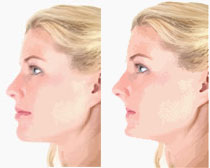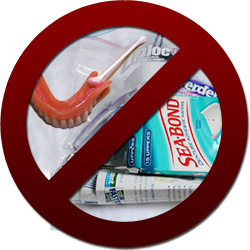Replacing Multiple Teeth with Dental Implants
Implants are the treatment of choice for multiple missing teeth
 Traditionally, several missing teeth would have been replaced with a removable partial or full denture.
Traditionally, several missing teeth would have been replaced with a removable partial or full denture.
Dental implants can now be used to anchor partial and full dentures. This prevents the slipping, irritation, and pain associated with "floating" partials and dentures. It also prevents the tedious removal of dentures for overnight soaking and cleaning. Dental implants also eliminate the need for denture adhesives. This allows you to enjoy eating the foods you previously avoided. With dental implants, your partials or dentures are firmly anchored to the jawbone, allowing them to feel much more like natural teeth.
Dental Implant Supported Dentures Prevent Bone Loss

Without implants or natural tooth roots to stimulate the jaw, bone loss occurs causing a sunken jaw.
Natural tooth roots and dental implant posts are fixed firmly in your jawbone. When you chew, these tooth roots and posts stimulate the jawbone and prevent it from shrinking.
You may have seen a person who looked prematurely old because their jawbone had shrunk after wearing floating dentures. Dental implants help preserve your jawbone and appearance.
The Alternative Can Cause Gum Pain
Dentures that slip and slide can cause sore and irritated gums. After the initial recovery from dental implantation, soreness and irritation is a thing of the past.
No Denture Adhesives Needed
 Dentures require adhesives to attach them to the gums, a substance that can be messy and sometimes doesn't work well at all. The permanence of dental implants is often a relief to those who've struggled with finding an adhesive that will make their dentures stay in place.
Dentures require adhesives to attach them to the gums, a substance that can be messy and sometimes doesn't work well at all. The permanence of dental implants is often a relief to those who've struggled with finding an adhesive that will make their dentures stay in place.
You'll also never have to get up in the morning and “put in your teeth” before facing the world!
The Success Rate of Dental Implants
After their healing period, the success rate of dental implants is between 94% and 98%. If you are a non-smoker with good oral hygiene, the percentage is closer to 98%.


.jpg) View Profile
View Profile Traditionally, several missing teeth would have been replaced with a removable partial or full denture.
Traditionally, several missing teeth would have been replaced with a removable partial or full denture. Without implants or natural tooth roots to stimulate the jaw, bone loss occurs causing a sunken jaw.
Without implants or natural tooth roots to stimulate the jaw, bone loss occurs causing a sunken jaw.  Dentures require adhesives to attach them to the gums, a substance that can be messy and sometimes doesn't work well at all. The permanence of dental implants is often a relief to those who've struggled with finding an adhesive that will make their dentures stay in place.
Dentures require adhesives to attach them to the gums, a substance that can be messy and sometimes doesn't work well at all. The permanence of dental implants is often a relief to those who've struggled with finding an adhesive that will make their dentures stay in place.